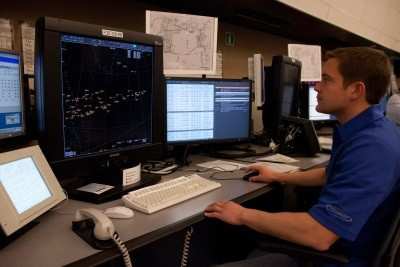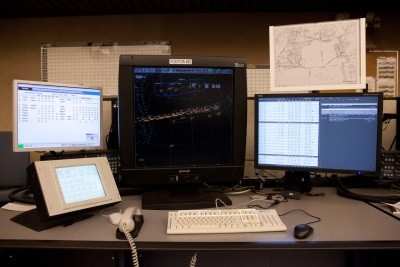Gander Automated Air Traffic System Plus (GAATS+) Allows Better
Traffic Flow, Planning
NAV CANADA Air Traffic Controllers who direct aircraft as they
transit across the North Atlantic - the busiest oceanic airspace in
the world - are now employing an enhanced system that makes oceanic
flight safer and more efficient. The technology upgrade, along with
a new initiative to improve the efficiency of operations in oceanic
airspace, will lead to significant airline cost savings through
reduced fuel burn, with accompanying reductions in greenhouse gas
emissions.

NAV CANADA Photo
The technology behind the improvements is known as the Gander
Automated Air Traffic System Plus (GAATS+). The controllers using
this technology are based in the Gander Area Control Centre in
Gander, Newfoundland. "Our Oceanic Air Traffic Controllers have a
global reputation for excellence in the provision of air traffic
services in the North Atlantic, handling well over 1000 flights a
day crossing the ocean in both directions," said John Crichton, NAV
CANADA President & CEO. "With GAATS+, they now have the world's
most advanced oceanic air traffic system.
"GAATS+ will allow better flow planning and a clearer picture of
traffic at any moment, despite the absence of radar in this
airspace," Crichton said. "This, in turn, will allow us to
implement procedures that increase capacity while maintaining
safety in collaboration with our Oceanic partner, NATS in
Prestwick, Scotland."
In March, NAV CANADA and NATS implemented an important
procedural change known as Reduced Longitudinal Separation Minima
(RLongSM). This allows properly equipped aircraft to fly on tracks
across the Atlantic with a separation of five minutes, versus the
traditional 10 minutes for non-radar airspace. RLongSM requires
aircraft to be equipped with Global Navigation Satellite System
(GNSS), Automatic Dependent Surveillance - Contract (ADS-C) and
Controller-Pilot Data Link Communication (CPDLC). ADS-C equipped
aircraft automatically provide position reports, which are fed to
controller displays through the GAATS+ system. CPDLC allows
controllers and pilots to communicate through short text-based
messages.

NAV CANADA Photo
Along with other procedural improvements, this will allow more
aircraft to access optimal altitudes. The expected result is an
estimated $1 million in customer fuel savings in the first year,
along with 3,000 metric tons of emissions savings.
GAATS+ provides significant enhancements to the original GAATS
system, including electronic flight strips. Electronic strips make
it easier to track and transfer responsibility for an aircraft
between controller positions as the aircraft flies through sectors
while automated updates mean less manual inputting of information.
The system also features increased automation of data exchange with
other air traffic facilities and integrates a series of automation
tools such as conflict prediction and data link communication for
position reports.
The GAATS+ system also provides controllers with a snapshot of
current and planned traffic as well as available conflict-free
route profiles, allowing the controller to easily identify an
aircraft's preferred route and provide a clearance. It provides
surveillance capabilities through the integration of radar feeds
from Canada's North Warning System in the North East Coast of
Canada and will allow future integration of surveillance capability
currently being expanded through Automatic Dependent Surveillance -
Broadcast (ADS-B) over southern Greenland.

NAV CANADA Photo
This will bring additional coverage in airspace that previously
operated solely under procedural control. The additional
surveillance capability will support a further reduction in
separation required between aircraft from five minutes to five
nautical miles in portions of the North Atlantic, leading to
further fuel and GHG emissions savings.
 ANN's Daily Aero-Linx (04.15.24)
ANN's Daily Aero-Linx (04.15.24) Classic Aero-TV: 'No Other Options' -- The Israeli Air Force's Danny Shapira
Classic Aero-TV: 'No Other Options' -- The Israeli Air Force's Danny Shapira Aero-News: Quote of the Day (04.15.24)
Aero-News: Quote of the Day (04.15.24) Airborne 04.16.24: RV Update, Affordable Flying Expo, Diamond Lil
Airborne 04.16.24: RV Update, Affordable Flying Expo, Diamond Lil ANN's Daily Aero-Term (04.16.24): Chart Supplement US
ANN's Daily Aero-Term (04.16.24): Chart Supplement US





